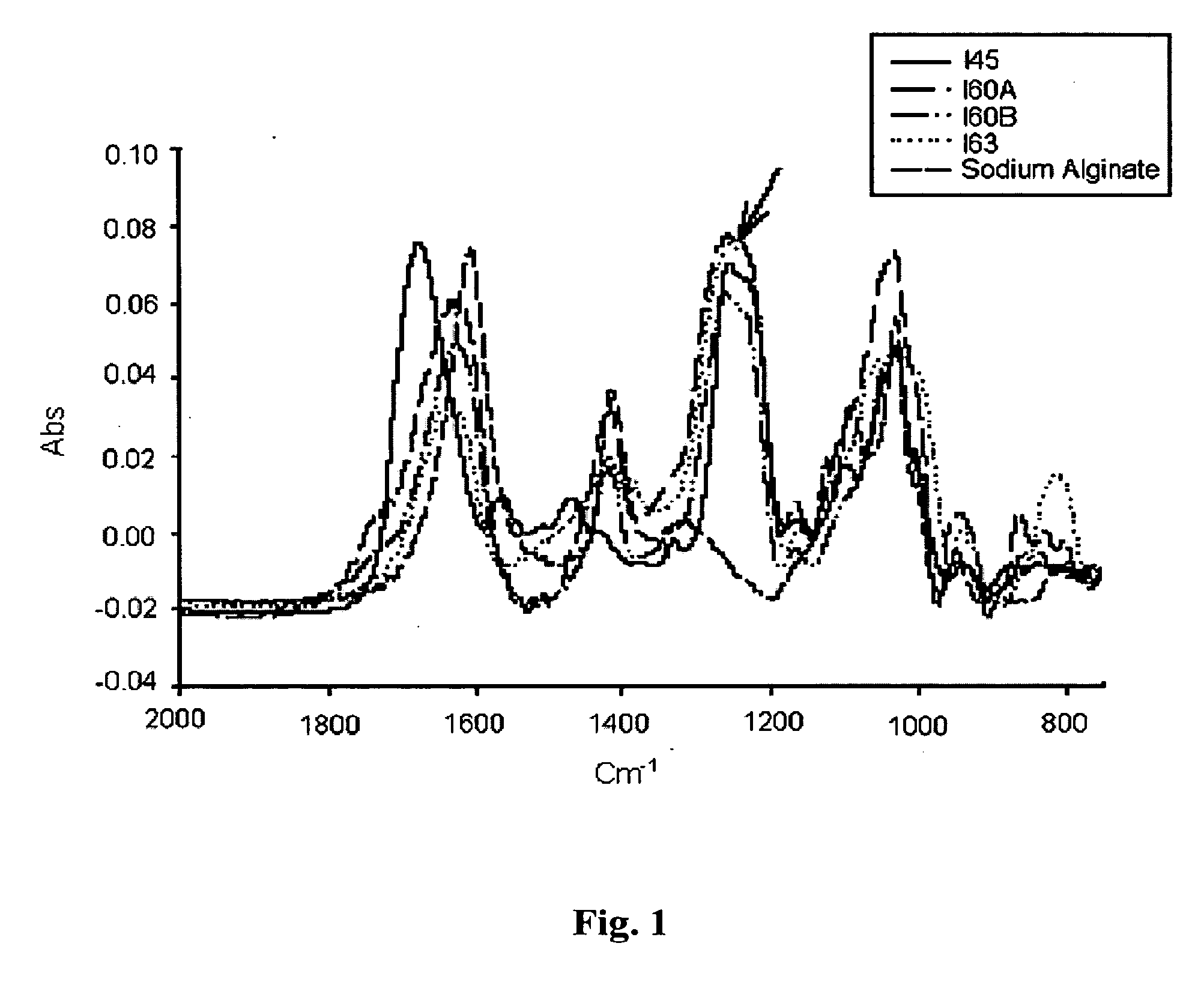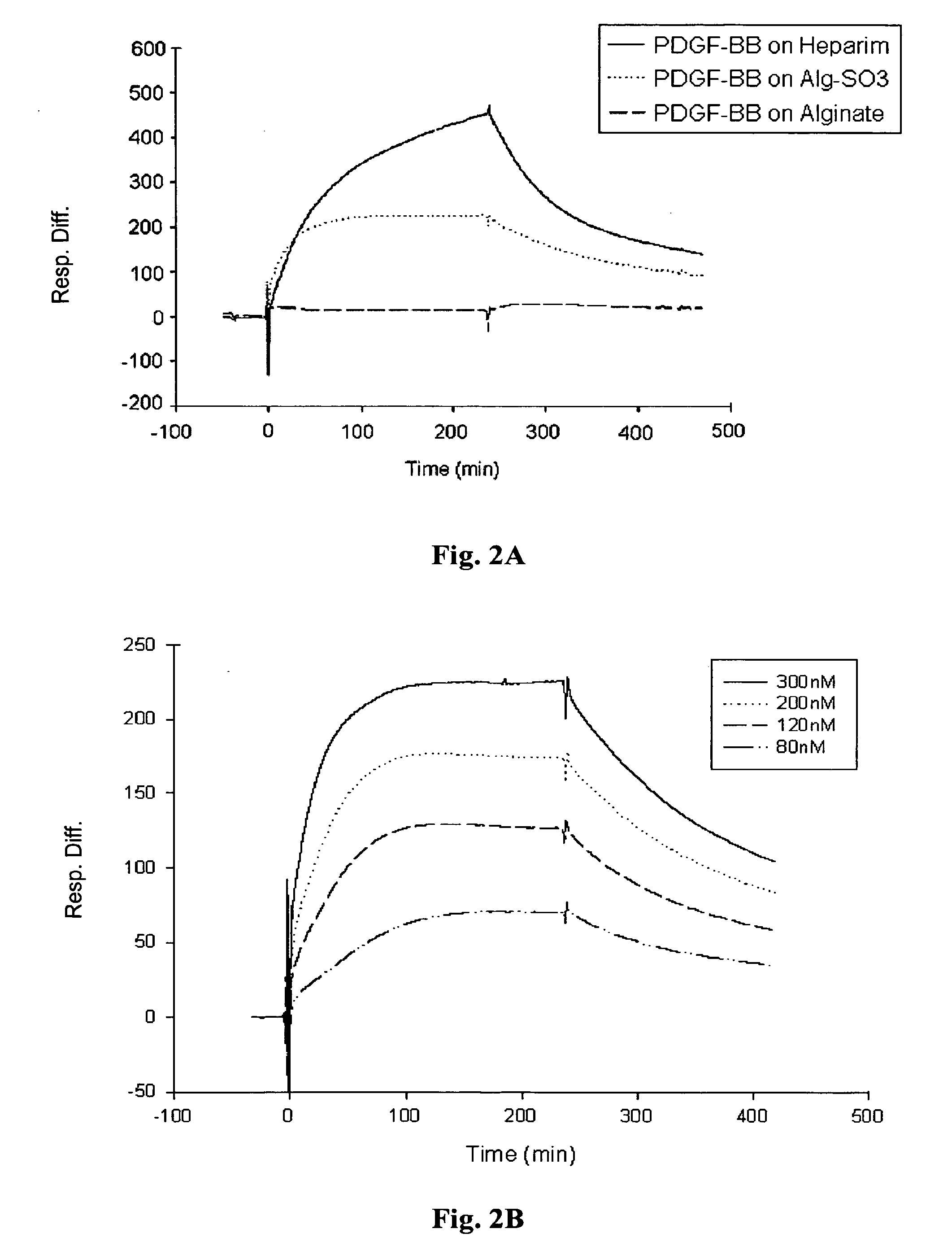Bioconjugates comprising sulfated polysaccharides and their uses
a technology of sulfated polysaccharides and bioconjugates, which is applied in the field of sulfated polysaccharides and to bioconjugates, can solve the problems of less effective
- Summary
- Abstract
- Description
- Claims
- Application Information
AI Technical Summary
Benefits of technology
Problems solved by technology
Method used
Image
Examples
example 1
Method of Alginate Sulfation and Product Analysis
[0088] To confer specificity on the alginate for its use as a delivery system, we developed the bioconjugate concept of alginate sulfate. The properties of alginate sulfate, such as biocompatibility, hydrophilicity, and the simple method of its formulation (physical cross-linking) as well as its low cost (of production and sulfation) are advantageous to its application for the controlled delivery of cytokines, growth factors and heparin-binding polypeptides, as well as a scaffold for tissue engineering.
[0089] Alginate sulfation was conducted by the sulfuric acid / carbodiimide method, essentially as described in U.S. Pat. No. 6,388,060, hereby incorporated by reference in its enterity as if fully described herein. In brief, the reaction is comprised of two steps: first, converting sodium alginate to alginic acid by batch ion exchange and then titration with tributylamine (TBA) yielding alginate-TBA. The second step consists of 0-sulfa...
example 2
Biomolecular Interactions of Alginate Sulfate and Heparin-binding Polypeptides by SPR Technology
[0097] Real-time biomolecular interaction analysis was performed using the BlAcore 3000 instrument (Pharmacia Biosensor AB, Sweden), operated with BIA evaluation version 3.2 software. All experiments were preformed, at 25° C., using HBS (10 mM HEPES, 0.15M NaCl, 3 mM EDTA, 0.005% surfactant P20, pH 7.4) as a running and dilution buffer.
[0098] (i) Immobilization of the ligands to sensor chip: The different polysaccharide samples were immobilized onto the sensor chip via biotin-avidin chemistry. Biotinylated sample of heparin-albumin was purchased from Sigma-Aldrich Chemicals (St Lewis, Mich.) and biotinylated samples of alginate and alginate sulfate were prepared using the method described in Polyak et al (2004). The biotinylated samples of the polysaccharides were immobilized onto streptavidin sensor chip (SA, Pharmacia Biosensor AB) as follows: the sensor chip was pulsed three times wi...
example 3
Sustained Release from Alginate / alginate Sulfate Capsules
[0104] The example shown herein examines the capability of alginate sulfate to sustain the release of the angiogenic heparin-binding peptide, bFGF, from microspheres compared to microspheres composed of only unmodified alginate.
[0105] (i) Microsphere preparation and bFGF encapsulation: Sodium alginate (high G content, FMC Biopolymers) solution 1% (w / v DDW) was mixed in different volume proportions with alginate sulfate solution 1% (w / v DDW). bFGF (0, 0.2, 0.5, 1, 2 μg / ml) was added to alginate / alginate sulfate mixture, and incubated for 1 h, 37° C. The mixture was collected into a syringe (18G) and was dropped into stirred CaCl2 solution (10-12 ml, 0.15M). The capsules were allowed to stir at room temperature for 0.5 h until gelation is complete and centrifuged (1500 RPM, 25° C., 10 min). The supernatant was removed and a sample (1 ml) from the capsules containing bFGF was suspended in 1 ml culture medium (CM) DMEM (1% Pen-S...
PUM
| Property | Measurement | Unit |
|---|---|---|
| Volume | aaaaa | aaaaa |
| Volume | aaaaa | aaaaa |
| Volume | aaaaa | aaaaa |
Abstract
Description
Claims
Application Information
 Login to View More
Login to View More - R&D
- Intellectual Property
- Life Sciences
- Materials
- Tech Scout
- Unparalleled Data Quality
- Higher Quality Content
- 60% Fewer Hallucinations
Browse by: Latest US Patents, China's latest patents, Technical Efficacy Thesaurus, Application Domain, Technology Topic, Popular Technical Reports.
© 2025 PatSnap. All rights reserved.Legal|Privacy policy|Modern Slavery Act Transparency Statement|Sitemap|About US| Contact US: help@patsnap.com



